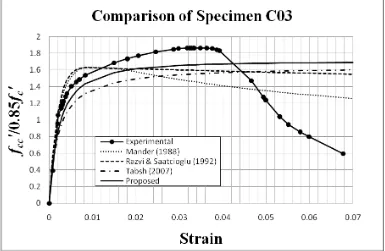Analytical Confining Model of Square Reinforced Concrete Columns
using External Steel Collars
Pamuda Pudjisuryadi
1, Tavio
2and Priyo Suprobo
31,2,3
Sepuluh Nopember Institute of Technology (ITS), Surabaya, Indonesia
1
[email protected],
2[email protected],
3[email protected]
Abstract
Confinement in concrete column has been well known to improve its strength and ductility. Up to present, traditional transverse steel is still used as internal confinement in concrete column. Many researchers have proposed various stress-strain relationships for confined concrete under different conditions. In general, all these models suggested increases both in compressive strength and ductility. The improved ductility is characterized by the increase of ultimate compressive strain and the flatter post-peak descending branch of the curve. Recently, research on concrete confinement has been developed further from internal to external techniques. The increasing demand of reinforced concrete column retrofits is the main reason to develop such techniques. Some external techniques have been proven to be successful in retrofitting circular concrete columns. Experimental programs as well as confining models for externally confined circular columns have been developed. However, it is hard to provide an effective confining stress by external retrofit on square or rectangular concrete column. The non-uniform confining stress on column was due to high stress concentration at the column corners. Only a few experimental and analytical studies addressed these issues. This paper proposes an analytical model for predicting the peak strength of square concrete columns confined by external retrofit as well as the shape of the improved stress-strain curve. Analytical study is also presented to provide a brief idea on the proposed analytical model in comparison with some developed models. The proposed model is also compared with the experimental results by other researchers. It is shown that the proposed analytical model can predict the behavior of externally retrofitted square concrete columns reasonably well.
Keywords: analytical model, external retrofit, square concrete columns, stress-strain curve
1. Introduction
are the increment of compressive strength, flatter post peak descending branch of the curve, and increment of ultimate compressive strain (increment of ductility).
Besides the conventional confinement studies, recent research are extended to external confinement approach [5-8]. It is essential to develop such approach due to the high demand of concrete columns retrofits. Early studies mainly deal with retrofitting circular concrete columns, and have been proven by experiments to be successful. However, for rectangular and square columns, predicting effective confining stress by external retrofit is not a simple task. Similar to internal confinement on these sectional shapes, the confining stress is not uniform due to stress concentration in the corners. Some experimental and only a few analytical studies are found to address this problems [9-11]. The complexity of external confinement includes failure mechanism, contact behavior between concrete and external confinement elements, and distribution of confining stress in 3D space, which can be totally different to those of conventional stirrups. In this paper, an analytical model of axial stress-strain curve of square columns confined by external steel collars is proposed. The research should provide better understanding of the external steel collar confinement behavior which aids a reliable use of this method on square concrete columns.
2. Proposed Effective Equivalent Uniform Confining Pressure (
f
e)
In an externally confined concrete model, definition of confining pressure can be modified from available definitions which were developed on the basis of internal confinement model. It is important to predict this confining stress, since it is the basis to determine the peak strength and generate the stress strain curve. This paper proposes new model to define effective equivalent uniform confining pressure for external confinement model (fe).
Firstly, consider a typical square concrete column which is externally retrofitted by steel collars (by steel angle sections in this explanation) as illustrated in Figure 1. The notations b,
S, and Sc are the dimension of the square column, spacing of steel collar elements, and clear spacing of steel collar elements, respectively.
In a plane across the section, the confining stress is not uniform as shown in Figure 2(a). Normally, parabolic-shaped regions at the sides of the columns (the shaded area) are assumed to be ineffective due to relatively weaker middle side confinement compared to the stiffer corners. The expression of the ineffectively confined area (Apar) is adopted from Mander, Priestley, and Park [2, 3] and Lee, Hegemier, and Phillippi [11] as expressed in Eq. 1.
2
Similar ineffective confine regions are also assumed in vertical direction between adjacent confinement elements as in Figure 2(b). With consideration of both ineffective regions in horizontal and vertical directions, and average effectively confined cross sectional area, Ae, can be adopted from Mander, Priestley, and Park [2, 3] as expressed in Eq. 2.
2
e e
c c
A k
A
(3)
where Acc is the net core area of the columns (Ac minus the area of longitudinal bars, if any). This factor is used to modify the equivalent uniform confining pressure (f, which is explained
later) into the effective equivalent uniform confining pressure, fe as expressed in Eq. 4.
k f
f e e
(4)
Figure 1.Three-dimensional Illustration of the Typical Columns
Figure 2. The Parabolic-Shaped Ineffectively Confined Region at: (a) Cross Section; and (b) Along the Height of the Column
observed that external steel collars provide the confining pressure through combined bending and axial mechanism. This phenomenon is different from the assumption for internal transverse reinforcement which only depends on axial action because of the relatively small bending stiffness. Consider a bulged externally retrofitted concrete column under axial loading in Figure 3(a). The steel collars are assumed to deform such a way that they maintain the compatibility of outward expansion of the concrete column. This deformation is logically larger at the mid-sides than at the corners. The steel collars are assumed to fail in combined axial and bending mechanism at the corners and mid-sides of the columns (plastic hinges are developed). With the assumption of uniform generated confining pressure, the equilibrium of the forces in cross sectional plane can be seen in Figure 3(b) (only a quarter of the model is analyzed due to double symmetric condition).
By using an equilibrium condition of forces, the axial force (p) and the bending moment (m) developed in the steel collars can be expressed as a function of equivalent uniform confining pressure (f), dimension of column (b), and spacing of steel collars
(S), as expressed in Eqs. 5 and 6.
S b f p
2
(5)
S b f m
16 2
(6)
Figure 3.(a) Bulged Steel Collars Due to Lateral Expansion of Axially Loaded Concrete Column; and (b) Equilibrium of Forces Analyzed at a Quarter of the
Cross Section
With nominal axial and bending capacities (pn and mn) of steel collars given, and adopting criteria of combined axial and bending failure of steel (Eq. 7), f can be calculated. In
calculating nominal capacity, the reduction factors () in Eq. 7, shall be taken as 1.0.
8
1 1 .0
9
n n n
p m p
f o r
p m p
1 1 .0
2 n n n
p m p
f o r
p m p
(7b)
Moreover, for bolted corners, there are chances that the bolts fail before the steel collars [10]. In this case, the plastic moment generated in Figure 3(b), should be modified. If the plastic moment capacities of bolts and steel collars are defined as m, and k m respectively, the new equilibrium condition can be seen in Figure 4. Factor k defines the ratio of plastic moment capacities of steel collars with respect to that of bolts (> 1.0).
It can be shown that the moment generated in bolts can still be expressed as a function of previous known variables (Eq. 8) and Eqs. 5 to 7 still can be used to calculate f.
kS
b f m
1 8
2
(8)
If the bolts are pre-tensioned significantly that they provide active initial confinement pressure, further modifications are necessary. The final equivalent uniform confining pressure (f) should be the resultant of initial confining pressure (f0) and the calculated confining
pressure from Eqs. 5 to 8. In this case, the nominal axial capacity of the bolts (pn) in Eq. 7 should be reduced by the initial pretension force (Fb). With the assumption that pretension forces applied with inclined angle of 45 degrees (Figure 5(a)), the initial confining pressure (f0) in Figure 5(b), can be expressed in Eq. 9.
S b
F .
f b
2 0 5 2 0
(9)
The calculated equivalent uniform confining pressures (f) is then modified by using Eq. 4,
into effective equivalent uniform confining pressures (fe). The peak strength ( fcc) can be
determined by using available analytical model in terms of unconfined concrete strength ( fc0), and the proposed effective equivalent uniform confining pressure (fe).
Figure 5. (a) Pretension Forces in Bolts Connecting the Steel Collars at Corners; and (b) the Resulting Initial Confining Pressure
3. Proposed stress-strain Model for Externally Confined Concrete
As explained in previous section, once the confining pressure and corresponding peak strength determined, the stress strain curve can be generated by using available models. Many models have been developed, and mainly based on internally confined concrete. To develop such model for externally confined concrete can be a very challenging task. The shape of the stress strain curve will highly depend on the characteristics (failure mechanism, ductility, etc.) of external confining element. This section will review some well established models developed for internally confined concrete. The models are then compared to available experimental results of externally retrofitted confined concrete by using steel collars [10], and the necessary modifications are proposed.
3.1. Mander et.al. Model [2]
The widely used model proposed by Mander, Priestley, and Park [2, 3] expresses the stress-strain relationship with a single function. Eqs. 10 to 16 show the corresponding model.
f = compressive strength of confined concrete (MPa)
0
c
f = compressive strength of unconfined concrete (MPa)
cc
= compressive strain of confined concrete corresponding to fcc
c
f = concrete stress as a function of concrete strain (MPa)
3.2. Razvi and Saatcioglu Model [14]
The Razvi and Saatcioglu [14] proposed stress strain relationship of confined concrete with non linear ascending branch and linear descending branch as expressed in Eqs. 17 to 24.
e
= compressive strain of confined concrete corresponding to fcc
01
= compressive strain of unconfined concrete corresponding to fc0
85
= compressive strain of confined concrete corresponding to 0.85 fcc
085
= compressive strain of unconfined concrete corresponding to 0.85 fc0 = volumetric ratio of confinement element with respect to concrete core
It should be noted that the values of 01 and 085 is valid for unconfined concrete strength
3.3. Modified Tabsh Model [12]
The model proposed by Tabsh [12] combines Mander model [2, 3] and Hoshikusuma model [13] for the ascending and descending branches of stress-strain curve, respectively. The peak strength fcc is determined exactly the same as Mander model (Eq. 10). The
stress-strain curve can be generated using expressions given in Eqs. 25 to 29.
65
= compressive strain of unconfined concrete corresponding to fc0
s
= volumetric ratio of external steel collar with respect of concrete core
A modification is proposed to stimulate the character of externally confine concrete columns. Strain corresponding to the peak stress in Eq. 25 seems to be quite large from model proposed by Tabsh [12] which was originally developed for high strength concrete column Square Section (HSS) collars confinement.
4. Comparison of Analytical Stress-Strain Models
In order to give clear view of the models described in previous section, some typical square concrete columns externally retrofitted by steel collars are analyzed. The data of the mentioned specimens (namely S1, S2, and S3) as well as the resulting effective equivalent uniform confining pressure (fe) and peak strength (
5 6. s
) are presented in Table 1. Stress-strain
curves (normalized to 0.85 fc) are then generated analytically for each described model. In
this simulation, the unconfined concrete strength ( fc0) is assumed as large as 85 percent of cylinder compressive strength ( fc). It is assumed that there is no significant pretension force
Table 1. Data of Column Specimens
Description Specimen
S1 S2 S3
Column dimension, d (mm) 150
Steel collar spacing, S (mm) 150 100 50
Steel collar section, leg × leg × thickness (mm) HSS 38 × 38 × 3.8
Volumetric ratio of confining element, s (%) 12.9 19.3 38.6
Yield strength of steel collar, fy (MPa) 240
Unconfined concrete strength, fc0 (MPa) 20
Strain at unconfined concrete strength, c0 0.003
Modulus of elasticity, Ec (MPa) 22811
Effective equivalent uniform confining pressure, fe (MPa) 0.136 0.326 0.954
Peak strength of confined concrete, fcc (MPa) – Mander [2] & Tabsh [12] 20.93 22.17 25.94
Peak strength of confined concrete, fcc (MPa) – Razvi & Saatcioglu [14] 21.28 22.64 26.44
Figure 7. Stress-strain Curves of Specimens S1, S2, and S3 (Razvi and Saatcioglu Model)
Figure 9. Stress-strain Curves of Specimens S1, S2, and S3 (Proposed Model)
It can be seen in Figures 6 and 7 that the stress-strain model proposed by Mander, Priestley, and Park [2, 3] as well as Ravzi and Satcioglu [4, 14], which were developed using the extensive conventionally confined concrete columns, possessed similar characteristics. The descending branches in both models depend on the level of confinement. Steeper descending slopes are seen in specimens with lower confinement. This character is widely accepted among researchers. More models commonly emphasize on the shapes of the descending branch of the curves. Many models have been proposed for different conditions.
To fit the stress strain curve of columns externally retrofitted by steel collars, vast experimental data are needed. Only a few researches have been done in this area. One of them is experiment done by Hussain and Driver [10]. The stress strain curves of these externally confined columns are characterized by relatively larger peak strain. Model proposed by Tabsh [12] seems to have such criteria (Figure 8). This paper proposed a modification to Tabsh model by reducing the value of peak strain as explained in Section 3.3 (Figure 9) to fit the available experimental results. Comparisons of the discussed models with the experimental results are presented in Section 5.
5. Stress-strain Comparison with Experimental Results
Experimental results of other authors are used to verify the analytical models. Hussain and Driver [10] conducted a compression test of square columns externally retrofitted by Hollow Square Section (HSS) steel collars. Figure 10 shows the typical specimens and steel collars, respectively. Eleven columns were tested with description as shown in Table 2. Other mechanical properties are available in Ref. 10. In the experiment, the bolts used in Specimens C02 to C05 were pre-tensioned with different levels. Figure 11 shows the axial stress-strain curve of the columns.
due to machine capacity limitation. Specimens applied with welded corners are also excluded in this study (C06 to C09). Normalized analytical stress-strain curves are plotted against the experimental results. The comparison of analytical and experimental results is presented in Figures 12 to 15.
Figure 10. Typical Collared Column Specimens: (a) Elevation View; (b) Bolted; and (c) Welded [10]
Figure 11. Normalized Stress-Strain Curves [10]
Figure 12. Comparison of Normalized Stress-Strain Curves for Specimen C01
Figure 13. Comparison of Normalized Stress-Strain Curves for Specimen C02
Figure 15. Comparison of Normalized Stress-Strain Curves for Specimen C04
It is shown in Figures 12 to 15 that the peak strength can be predicted reasonably well. The figures also show that the proposed derivation of effective equivalent uniform confining stress is reliable. Only Specimen C03 indicates slightly higher deviation.
Predicting peak strain is proven to be a more difficult task. Both Mander and Saatcioglu models predict the peak strain considerably lower. The rate of strength degradation in both models also did not match the experimental results. Meanwhile, Tabsh model predict the peak strain significantly higher such that the rate of degradation cannot be observed. However, by modifying the value of the peak strain of Tabsh model (proposed model), it can be seen that the Tabsh model can predict the behavior of the specimen much better than the other models. Strength degradations of Specimens C01 and C04 can be simulated by the proposed model, while all the other models fail to do so. Moreover, the post peak behavior of specimens observed from the experimental results did not show any certain pattern. Some specimens showed earlier failure (C03 and C04), while test on C05 was not completed due to the limitation of the testing machine capacity.
6. Concluding Remarks
From above observations and discussions, some points can be concluded. Firstly, the proposed formulation to calculate the effective equivalent uniform confining stress (fe) can excellently predict the peak strength. Secondly, the basic shape of stress strain curves is best predicted using Tabsh model. However, for externally confined concrete columns, the peak strain suggested by Tabsh should be adjusted to lower values. The modification of expression
8 3. s
in Eq. 25 to 6.5
s
Acknowledgements
This study is supported by the Department of Civil Engineering, Sepuluh Nopember Institute of Technology (ITS), Surabaya, Indonesia. The authors greatly acknowledge for all the support received.
References
[1] S. A. Sheikh, “A Comparative Study on Confinement Models”, ACI Journal, vol. 79, no. 4, (1982) July-August, pp. 296-306.
[2] J. B. Mander, M. J. N. Priestley and R. Park, “Theoretical Stress-Strain Model for Confined Concrete”, Journal of Structural Engineering, ASCE, vol. 114, no. 8, (1988), August 1, pp. 1824-1826.
[3] J. B. Mander, M. J. N. Priestley and R. Park, “Observed Stress-Strain Behavior of Confined Concrete”, Journal of Structural Engineering, ASCE, vol. 114, no. 8, (1988) August, pp. 1827-1849.
[4] M. Saatcioglu and S. R. Razvi, “Strength and Ductility of Confined Concrete”, Journal of Structural Engineering, ASCE, vol. 118, no. 6, (1992) June, pp. 1590-1607.
[5] Y. H. Chai, M. J. N. Priestley and F. Seible, “Analytical Model for Steel-Jacketed RC Circular Bridge Columns”, Journal of Structural Engineering, ASCE, vol. 120, no. 8, (1994) August, pp. 2358-2376. [6] M. Saafi, H. A. Toutanji and Z. Li, “Behavior of Concrete Columns Confined with Fiber-Reinforced
Polymer Tubes”, ACI Material Journal, vol. 96, no. 4, (1999) July-August, pp. 500-509.
[7] A. Z. Fam and S. H. Rizkalla, “Confinement Model for Axially Loaded Concrete Confined by Circular Fiber-Reinforced Polymer Tubes”, ACI Structural Journal, vol. 98, no. 4, (2001) July-August, pp. 541-461. [8] S. A. Carey and K. A. Harries, “Axial Behavior and Modeling of Confined Small-, Medium-, and
Large-Scale Circular Sections with Carbon Fiber-Reinforced Polymer Jackets”, ACI Structural Journal, vol. 102, no. 4, (2005) July-August, pp. 596-604.
[9] Y. Xiao and H. Wu, “Retrofit of Reinforced Concrete Columns using Partially Stiffened Steel Jackets”, Journal of Structural Engineering, ASCE, vol. 129, no. 6, (2003) June, pp. 725-732.
[10] M. A. Hussain and R. G. Driver, “Experimental Investigation of External Confinement of Reinforced Concrete Columns by Hollow Structural Section Collars”, ACI Structural Journal, vol. 102, no. 2, (2005) March-April, pp. 242-251.
[11] C. S. Lee, G. A. Hegemier and D. J. Phillippi, “Analytical Model for Fiber-Reinforced Polymer-Jacketed Square Concrete Columns in Axial Compression”, ACI Structural Journal, vol. 107, no. 2, (2010) March-April, pp. 208-217.
[12] S. W. Tabsh, “Stress-Strain Model for High-Strength Concrete Confined by Welded Wire Fabric”, Journal of Materials in Civil Engineering, ASCE, vol. 19, no. 4, (2007) April, pp. 286-294.
[13] J. Hoshikusuma, K. Kawashima, K. Nagaya and A. W. Taylor, “Stress-Strain Model for Confined Reinforced Concrete in Brigde Piers”, Journal of Structural Engineering, ASCE, vol. 123, no. 5, (1997) May, pp. 624-633.
[14] S. Rasvi and M. Saatcioglu, “Confinement Model for High Strength Concrete”, Journal of Structural Engineering, ASCE, vol. 125, no. 3, (1999) March, pp. 281-289.
[15] T. and B. Kusuma, “Stress-Strain Model for High-Strength Concrete Confined by Welded Wire Fabric”, Journal of Material in Civil Engineering, ASCE, Discussion, vol. 21, no. 1, (2009) January, pp. 40–45. [16] T., B. Kusuma and P. Suprobo, “Experimental Behavior of Concrete Columns Confined by Welded Wire
Fabric as Transverse Reinforcement under Axial Compression”, ACI Structural Journal, vol. 109, no. 3, (2012) May-June, pp. 339-348.
[17] T., I. N. Budiantara and B. Kusuma, “Spline Nonparametric Regression Analysis of Stress-Strain Curve of Confined Concrete”, Civil Engineering Dimension, Petra Christian University, vol. 10, no. 1, (2008) March, pp. 14-27.
[18] T. and A. Tata, “Predicting Nonlinear Behavior and Stress-Strain Relationship of Rectangular Confined Concrete Columns with ANSYS”, Civil Engineering Dimension, Petra Christian University, vol. 11, no. 1, (2009) March, pp. 23-31.
Authors
Pamuda Pudjisuryadi, is a Ph.D. Candidate in the Department of Civil Engineering, Sepuluh Nopember Institute of Technology (ITS), Surabaya, Indonesia. He received his Master Degree from the School of Civil Engineering at Asian Institute of Technology (AIT), Bangkok, Thailand. His research interests include structural analysis, earthquake engineering, and retrofitting method of reinforced concrete structures.
Tavio, is a Professor of Civil Engineering at ITS. He received his Ph.D. from the School of Civil and Environmental Engineering at Nanyang Technological University (NTU), Singapore. He is a Member of the Joint ACI-ASCE Committee 441: Reinforced Concrete Columns, International Association for Life-Cycle Civil Engineering (IALCCE), American Concrete Institute (ACI), and Precast/Prestressed Concrete Institute (PCI). His research interests include numerical modeling of reinforced concrete structures, behavior of flat plates, precast and prestressed concrete structures, and behavior of confined concrete columns under seismic loading.
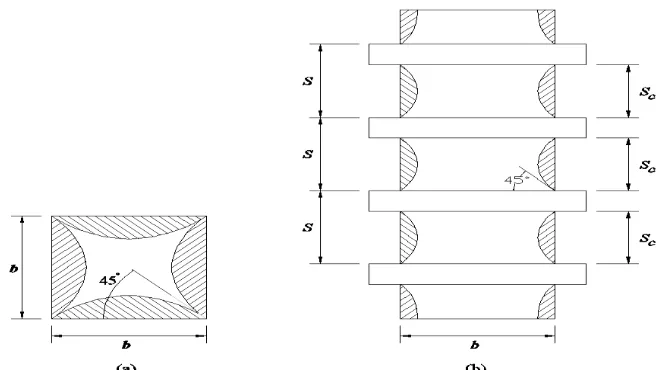
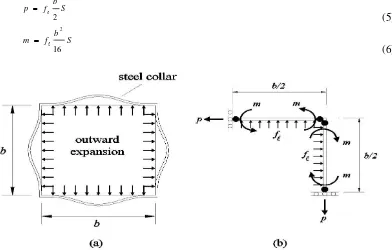
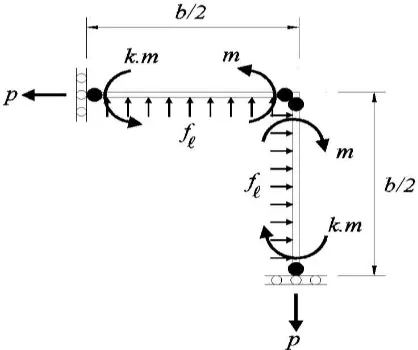
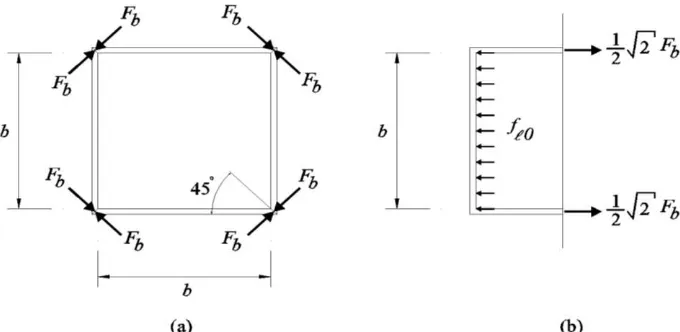
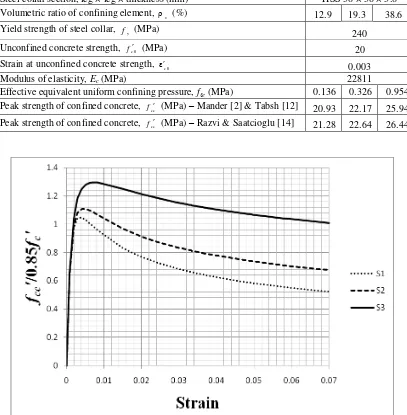
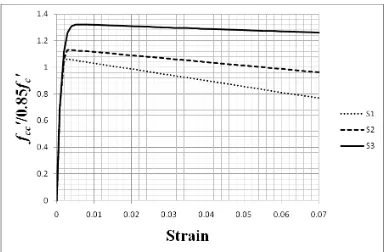
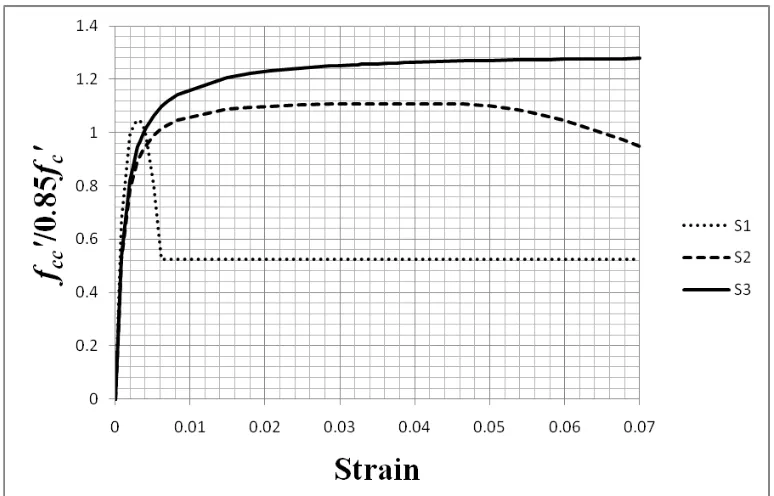
![Table 2. Description of Column Specimens [10]](https://thumb-ap.123doks.com/thumbv2/123dok/1582300.2054181/12.612.96.507.416.573/table-description-of-column-specimens.webp)
![Figure 11. Normalized Stress-Strain Curves [10]](https://thumb-ap.123doks.com/thumbv2/123dok/1582300.2054181/13.612.114.484.84.323/figure-normalized-stress-strain-curves.webp)
